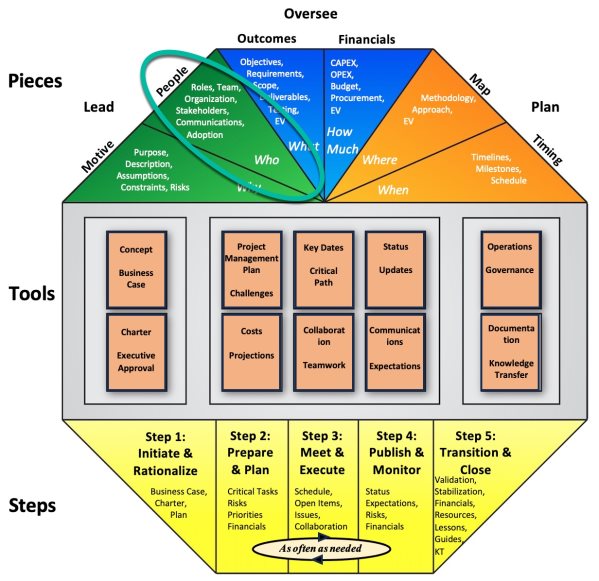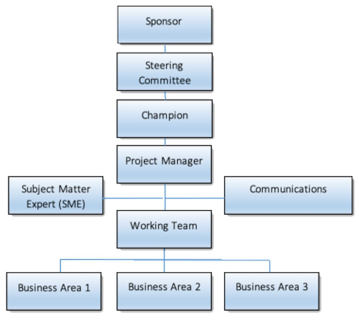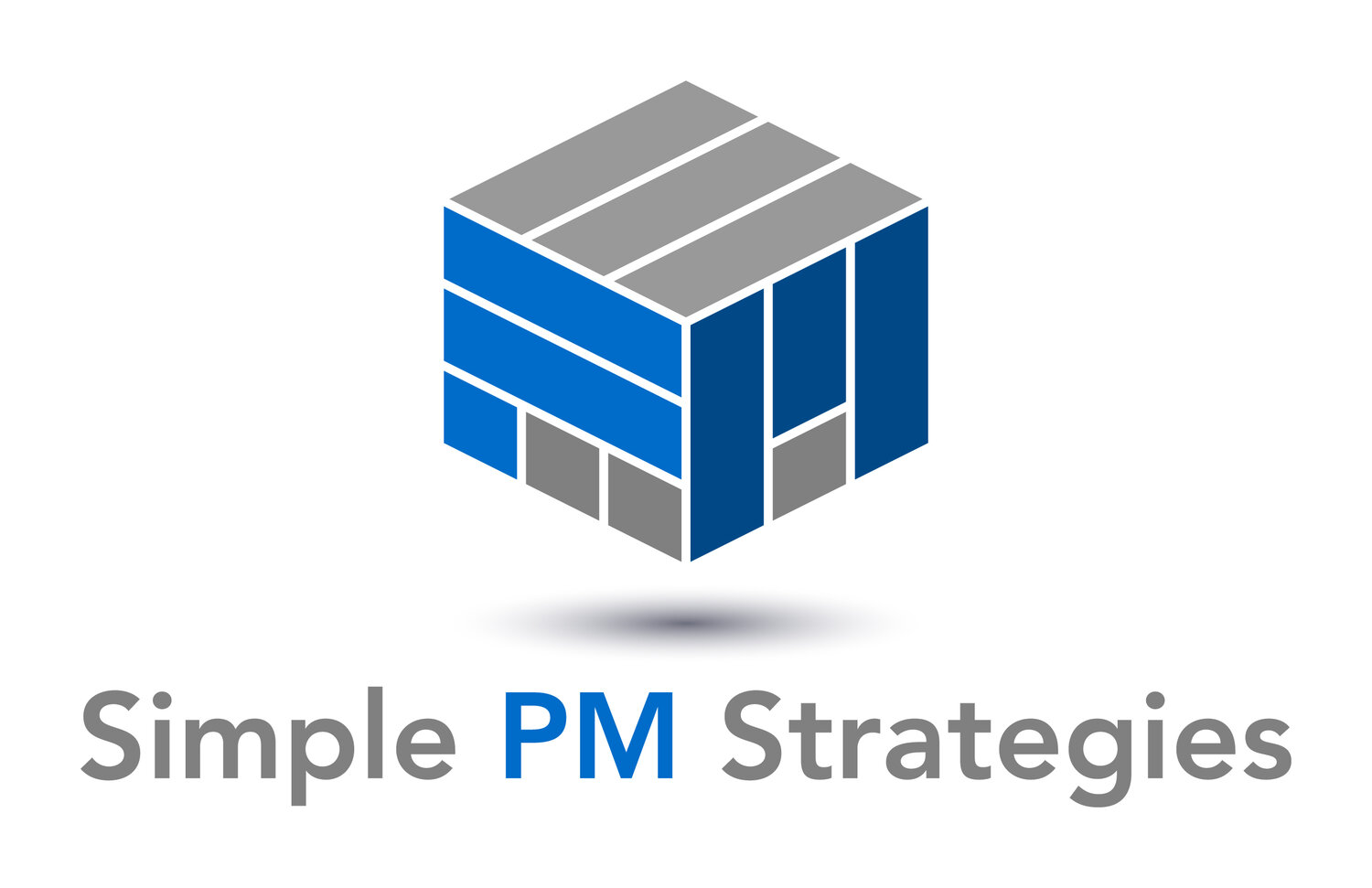4 Steps to Clarify the Roles Decision Structure for Your Project
The purpose of this blog is to define the steps to take when clarifying the roles decision, or governance structure for your project. In other words, how are decisions made?
Roles are under the LEAD domain and within the People segment in the MPM model.

Roles are under the LEAD domain and within the People segment in the MPM model
Defining the Decision Structure for Roles
This blog compliments defining all of the roles and responsibilities as covered in this particular blog post.
However, in this blog post the goal is to walk through the decision-making structure for your project.
In other words, if a decision has to be made regarding one option or the other how is that decision made? What is the authority structure for making those decisions?
Step 1: Start with an organization chart
Below is an example of an organization chart for a project. We’ll discuss the decision-making structure that is above the project manager in this organization chart.

Start with a project organization chart
First, start with the project manager, then add the Sponsor and Champion; which can also be the same person. Develop the Steering Committee membership later.
The project manager is expected to have the ultimate decision-making authority within the working or project team by definition of the role, but all of those assumed responsibilities should be stated in the role responsibility descriptions so there is no ambiguity.
Some examples of decision-making responsibilities include:
- Project Manager
- Escalate to Project Champion if issues or decisions need resolution or approval between Steering Committee Meetings
- Single point of contact directly with business leaders and teams to manage all project schedule commitments and milestones, and manage and resolve issues
Then fill in the other roles such as Project Champion and Project Sponsor.
Some further examples of decision-making responsibilities are:
- Project Champion
- Handle any Decision Requests and escalate to the Project Sponsor or Steering Committee if assistance is needed with decisions
- Review and decide on any Issues for which the Working Team cannot come to a consensus-based decision due to a dispute, uncertainty or other reason
These are just a sampling of decision-making responsibilities for these two roles. Additional details are provided in the workshop and online course materials.
The example structure is just a starting point. Define the decision-making structure to what is appropriate for your organization.
Step 2: Fit the roles to your organization
In the example org chart illustrated above, the Sponsor could be a senior level executive who represents the project at the highest levels in an organization.
The manager managing the project takes on the Project Manager role and their manager would then be the Champion.
The Champion is more hands-on with the Project Manager than the Sponsor, for such responsibilities as helping with the budget funding or resource allocation across the organization.
If the organization is small enough then the Manager who is the Project Manager may also be the Champion. It is advisable to have someone else as the Sponsor, so you have support at the executive table.
If the organization is very, very small, as in just handful of people then the Manager may carry three roles, the Project Manager, Champion, and Sponsor.
The point is to define the roles first, so that whoever is in that role, or if a person is fulfilling more than one role, it is clear to them what is expected of them for decision-making when they are taking on the responsibilities for that role.
Step 3: Ensure the decision-making path is clear
When the organization’s executive meets, maybe on a monthly basis, then whomever is in the Sponsor role, wears the hat of presenting the purpose and value being gained out of the project from its use of people and other resource, its financial spend, and what it is producing, and at that point is making decisions for the project based on what surfaces in the executive meeting.
Accompanying the organization chart is the details of decision making that compliments the diagram and builds on the details in the Role descriptions.
Developing role descriptions are detailed in the role-responsibilities-names table, as discussed in this blog post, also provided as a link earlier in this blog post.
Step 4: Assemble your steering committee
The steering committee is necessary for objective feedback and to help sort out the more senior problems around money, people, and time that your project may run into.

The Steering Committee helps with decision making around issues of money, people, and time
More examples of decision-making responsibilities:
- Steering Committee
- Authorizes requests for additional resources or funding if needed in order to maintain the project schedule
- Approves of extensions or delays to the schedule
These are just a sampling of decision-making responsibilities for the Steering Committee. Additional details are provided in the workshop and online course materials.
For the Steering Committee membership, define the decision-making responsibilities that the project expects from those roles and then meet with the Champion or Sponsor to get clarification.
Communicating the invites could be from yourself as the project manager, where you cc the Champion on the communication, or the Champion could contact them. It depends on your organization.
Summary
The decision-making structure for the project defines the authority for making decisions within the context of the project.
Start with the Project Manager role and then move to the Champion and Sponsor roles and define the authority for making project decisions.
After the decision-making for the Project Manager, Champion, and Sponsor are defined, then move to identifying the stakeholders to invite for the Steering Committee.
Adapt the roles, responsibilities, and names assigned to decision-making to fit your organization.
Action Steps / Apply This Knowledge
- Create an org chart for your project defining the key roles above the project manager.
- Describe the responsibilities of each role in decision-making
- Work with the Project Champion or Sponsor to identify stakeholders to invite to be on the Steering Committee.
- Prompt engineering guidance for AI GPTs such as chatGPT: “I’m a business leader launching a project whose purpose is Y, and delivering X. What are some options for an organization governance and decision making structure that I could provide in the charter?”
Learn More to Do More
Business evolves through change initiatives otherwise known as projects. The key to managing these change initiatives so you have more time, and less stress is to use simple strategies and tools.
Check out the Learning Hub’s other Articles with Actionable Steps, organized with a busy leader in mind, by topic or main idea, and with some AI GPT (e.g. ChatGPT) prompt engineering suggestions under the Action steps: https://simplepmstrategies.com/learning-hub-index
LEAD – Roles Decision Structure
© Simple PM Strategies 2024
